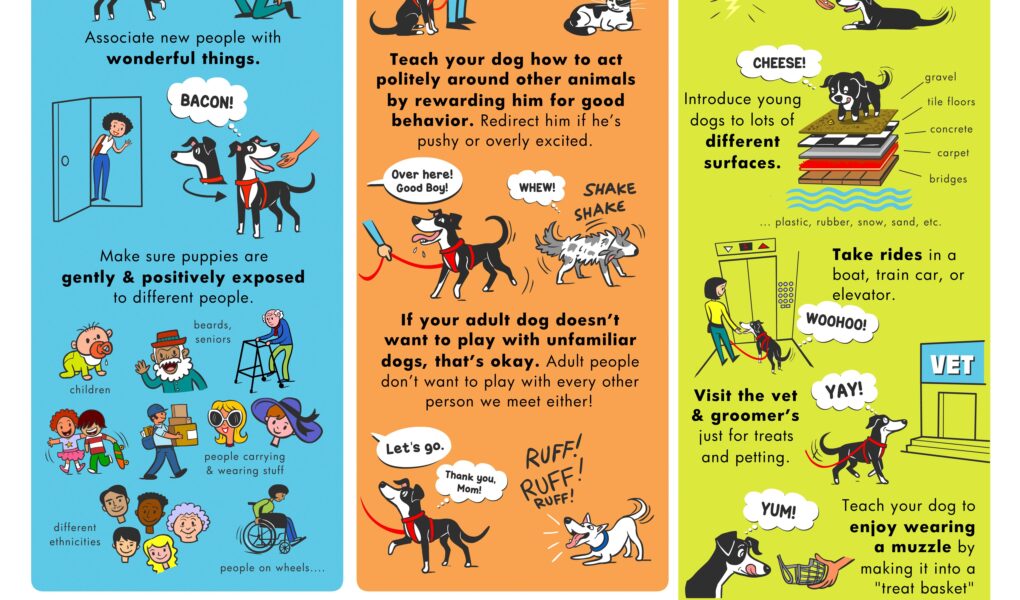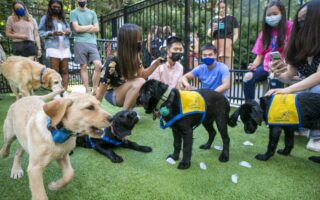Unleashing Potential: The Art of Dog Socialization
Imagine stepping into a vibrant park filled with the joyful barks of dogs as they frolic together, tails wagging in unison. Here, amidst the laughter of owners and the boundless energy of canines, lies a critical component of a dog’s happiness and well-being: socialization. For many dog owners, the term evokes images of playful encounters and new friendships forged in shared adventures. Yet, the process of socialization extends beyond mere playdates; it is a foundational element that shapes a dog’s behavior, temperament, and comfort in the world. In this article, we delve into the intricacies of dog socialization, exploring its importance, the stages of development, and practical tips to nurture your furry friend into a well-adjusted companion. By understanding the nuances of social interaction, we can ensure that every wag and woof resonates with confidence and joy. Join us as we embark on a journey toward stronger bonds and happier tails, one paw at a time.
Table of Contents
- Exploring the Importance of Dog Socialization in Early Development
- Effective Strategies for Introducing Your Dog to New Environments
- Building Positive Experiences: The Role of Play and Interaction
- Navigating Common Challenges in Dog Socialization and How to Overcome Them
- Q&A
- To Wrap It Up
Exploring the Importance of Dog Socialization in Early Development
Socialization is a critical phase in a puppy’s early development, laying the foundations for their emotional well-being and behavior throughout life. During this formative period, which typically spans from approximately three weeks to sixteen weeks of age, puppies are uniquely receptive to new experiences. Engaging them in a variety of settings can enhance their confidence and curiosity. Key benefits of early socialization include:
- Reducing Fear: Exposing puppies to diverse environments helps diminish fear responses, promoting adaptability.
- Building Friendliness: Interactions with different people, animals, and situations teach puppies to be friendly with others.
- Preventing Behavioral Issues: Well-socialized dogs are less likely to develop anxiety-related behaviors, such as aggression or excessive barking.
Effective socialization requires intentionality and variety. Puppy owners should strive to introduce their pets to a plethora of stimuli in both controlled and dynamic settings. Regular visits to parks, participating in puppy classes, or simply inviting visitors to the home can significantly contribute to a dog’s growth. Consider the following socialization strategies:
| Strategy | Description |
|---|---|
| Controlled Playdates | Arrange playdates with vaccinated and sociable dogs to promote positive interactions. |
| Exposure Sessions | Take puppies to different environments, such as busy streets, pet-friendly stores, and public transport. |
| Training Classes | Enroll in puppy training classes to teach basic commands while socializing with peers. |
Effective Strategies for Introducing Your Dog to New Environments
Introducing your dog to new environments can be an exciting journey for both of you. Start slow by choosing a calm and quiet place for the initial experience. This allows your dog to acclimate without overwhelming stimuli. Be sure to bring along familiar items, such as their favorite toy or a blanket, to provide a sense of security. As you explore, use a soft, encouraging voice, and reward your dog with treats for calm behavior in the new setting. This positive reinforcement helps build their confidence, making them more open to new experiences.
As your dog becomes more comfortable, gradually increase the levels of stimulation by moving to busier areas. Prioritize body language cues; observe your dog for signs of stress or fear, such as tucked tails or avoidance behaviors. If you notice these signs, it’s crucial to adjust the environment or take breaks as needed. Engaging in group classes or meet-ups with other friendly dogs can also enhance social skills in diverse settings. Remember to keep the experiences short and enjoyable, ensuring your dog associates new environments with positive moments and social interactions.
Building Positive Experiences: The Role of Play and Interaction
Engaging in play with other dogs is essential to fostering a well-rounded and adaptable canine companion. The pack dynamics that emerge during play sessions help dogs develop necessary social cues, such as understanding body language and vocalizations. Through these interactions, they learn to adjust their behavior based on feedback from their peers, which is crucial for their emotional intelligence. Some benefits of these social interactions include:
- Improved confidence: Dogs that play regularly are more secure in their social skills.
- Reduced anxiety: Positive experiences with other dogs can help diminish fear-based reactions.
- Enhanced problem-solving skills: Play can stimulate creativity and the ability to navigate social challenges.
The environment in which play occurs also plays a significant role in shaping a dog’s behavior. A safe and controlled space, such as a dog park or training facility, can facilitate positive experiences. Setting clear boundaries and having a watchful eye can ensure that everyone, dogs and humans alike, enjoys the interaction without fear of negativity. Below is a simple guide to creating a suitable setting for dog socialization:
| Factor | Recommendation |
|---|---|
| Space | Ensure ample room for dogs to roam freely. |
| Supervision | Always have a responsible adult monitoring playtime. |
| Playmates | Match dogs with similar sizes and energy levels. |
Navigating Common Challenges in Dog Socialization and How to Overcome Them
Dog socialization is an essential part of ensuring your furry friend becomes a well-rounded and happy companion. However, many pet owners encounter challenges along the way. Some common issues include fear of unfamiliar environments, dog aggression, and overwhelming stimuli from loud settings or large groups. To tackle these hurdles, it’s important to approach socialization gradually. Start by exposing your dog to less crowded areas before introducing them to busier environments. This allows them to acclimate comfortably, reducing anxiety and promoting confidence.
Another effective strategy is to create positive associations with new experiences. Use treats, praise, and toys to reward your dog for calm behavior during social encounters. Additionally, consider enrolling them in socialization classes, where they can learn in a controlled setting with other dogs. Below is a simple table illustrating some effective strategies and corresponding benefits:
| Strategy | Benefit |
|---|---|
| Gradual Exposure | Builds confidence |
| Positive Reinforcement | Encourages desired behavior |
| Socialization Classes | Safe environment for practice |
Q&A
Q&A: Understanding Dog Socialization
Q1: What is dog socialization, and why is it important?
A1: Dog socialization is the process of exposing your dog to various environments, people, and other animals to help them develop positive behaviors and reduce fear. It’s crucial because socialized dogs tend to be well-adjusted and confident, making them safer companions in diverse situations. Proper socialization can prevent behavioral issues such as aggression or anxiety, ensuring your dog can comfortably navigate the world around them.
Q2: When should I begin socializing my dog?
A2: The ideal time to start socializing your dog is during their critical socialization period, which typically ranges from 3 to 14 weeks of age. During this window, puppies are particularly receptive to new experiences. However, it’s never too late to socialize a dog; older dogs may require a more cautious approach with slower introductions to new situations.
Q3: How can I effectively socialize my dog?
A3: Start by introducing your dog to different environments, sounds, and people in a safe and controlled manner. Use positive reinforcement techniques, such as treats and praise, to encourage good behavior. Take them to parks, pet-friendly shops, and arrange playdates with other dogs. Always monitor your dog’s reactions and maintain a calm demeanor—this will help reinforce positive associations with new experiences.
Q4: What are some common mistakes people make during dog socialization?
A4: A common mistake is overwhelming the dog with too many new experiences all at once, which can lead to fear or stress. Additionally, using negative reinforcement can create anxiety or aggression. Lastly, neglecting to socialize a dog after their early months can result in a lack of exposure, leading to problematic behaviors in adulthood.
Q5: How do I know if my dog is properly socialized?
A5: A well-socialized dog will exhibit confidence and curiosity in new situations rather than fear or aggression. Look for signs of comfortable body language, such as relaxed ears and a wagging tail. If your dog can interact positively with other dogs and humans—without excessive barking, growling, or cowering—it’s a good indicator of successful socialization.
Q6: What should I do if my dog shows signs of fear or aggression during socialization?
A6: If your dog displays fear or aggression, it’s crucial to back off and reassess the situation. Gradually reintroduce them to the stimuli in a controlled manner, and keep encounters short and positive. Consulting a professional dog trainer or behaviorist can provide tailored strategies to help your dog overcome their fears while ensuring their safety and the safety of others.
Q7: Can dog socialization be beneficial for older dogs?
A7: Absolutely! While older dogs may require a different approach to socialization due to established behaviors, it is still possible and beneficial. Engaging in low-pressure social situations can enhance their confidence and reduce anxiety. With patience and the right techniques, older dogs can learn to enjoy new experiences and interactions just like puppies can.
Q8: How do I maintain my dog’s social skills as they grow?
A8: Socialization is an ongoing process. Regularly expose your dog to new experiences, environments, and other pets to reinforce their social skills. Continue to challenge them with training classes, group activities, and controlled playdates. Consistency and variety are key to helping your dog remain well-socialized throughout their life.
Q9: Are there specific activities that can help with socialization?
A9: Yes! Participating in puppy training classes, organized dog playgroups, and community events are excellent ways to promote socialization. Visiting dog parks can also provide social opportunities, but always supervise your dog to ensure they interact positively. Additionally, exposing them to different sounds, sights, and places—like car rides or busy urban settings—can further enhance their adaptability.
Q10: Any final tips for successful dog socialization?
A10: Be patient! Every dog is unique, and socialization is a journey that requires time and understanding. Focus on creating positive experiences, respect your dog’s comfort level, and enjoy the process of watching your furry friend flourish as a well-rounded companion. Remember, the world is a big place, and every day is a chance for a new adventure!
To Wrap It Up
the journey of dog socialization is a fascinating blend of science and art, a tapestry woven with threads of patience, understanding, and consistent effort. By fostering positive experiences and nurturing relationships with both humans and other animals, we not only enrich our dogs’ lives but also enhance our own. As you step outside with your furry friend for their next playdate or stroll through the park, remember that each interaction is a unique opportunity for growth and connection. With time, dedication, and a sprinkle of creativity, you can cultivate a well-socialized companion who thrives in any environment. So, unleash your potential as a dog owner, and watch your canine buddy flourish in a world filled with possibilities.



